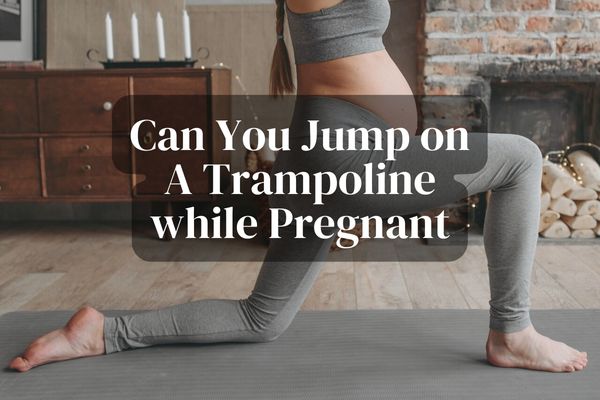Pregnancy is a time when women need to take extra care of their bodies to ensure a healthy pregnancy and a safe delivery. As such, exercise during pregnancy is a topic of great interest, with many women wondering what activities are safe and what should be avoided. One such activity that has become popular in recent years is trampolining.
Trampolining is a fun and exhilarating way to exercise, but when you are pregnant, you may wonder if it is safe to jump on a trampoline. After all, pregnancy is a delicate time, and any activity that may put your health or your baby’s health at risk should be avoided.
In this article, we will explore “Can you jump on a trampoline while pregnant?” in detail. We will discuss the risks and benefits of trampolining during pregnancy and factors that can affect the safety of trampolining while pregnant.
Understanding the Risks of Trampolining During Pregnancy
Trampolining involves bouncing on a surface that can be pretty hard and unforgiving, with the potential to cause injury. The bouncing motion of a trampoline can cause excessive pressure on the joints and ligaments of the body, which can harm a pregnant woman and her developing fetus.
Furthermore, trampolining requires balance and coordination, which can be compromised during pregnancy due to the changes in a woman’s center of gravity. Pregnant women may also experience reduced flexibility, increasing the risk of injury when jumping on a trampoline.
Factors That Can Affect the Safety of Trampolining During Pregnancy
Several factors can increase or decrease the risk of trampolining during pregnancy. These factors include:
Stage of Pregnancy
The safety of trampolining during pregnancy can vary depending on the stage of pregnancy. In the first trimester, the risk of miscarriage is higher, and it is generally advised that pregnant women avoid activities that could potentially cause a fall or abdominal trauma.
In the second and third trimesters, the growing size and weight of the uterus can make it more challenging to balance and coordinate movements, increasing the risk of falls and injury.
Individual Fitness Level
A pregnant woman’s fitness level is essential when deciding whether to engage in trampolining. Women who have been physically active before pregnancy and have continued to exercise throughout their pregnancy may be able to continue jumping on a trampoline, provided they take the necessary precautions and listen to their bodies.
However, women who are not physically active before pregnancy or have been advised to reduce their activity levels during pregnancy should avoid trampolining.
Pre-existing Medical Conditions
Certain pre-existing medical conditions can increase the risk of injury when jumping on a trampoline during pregnancy. These conditions include heart disease, high blood pressure, and placenta previa. Pregnant women with these conditions should consult their healthcare provider before engaging in physical activity, including trampolining.
Risks Of Trampolining During Every Stage Of Pregnancy
Pregnancy is a delicate time for women, and specific activities must be avoided or modified during this period. Trampolining is one such activity that raises concerns among expectant mothers. Here are the risks of trampolining during each stage of pregnancy.
Trampolining during the First Trimester
During the first trimester of pregnancy, there is a higher risk of miscarriage due to the risk of falls and blunt abdominal trauma. As a result, it is best to avoid trampolining altogether during this period.
Additionally, the first trimester is crucial for fetal development, and any activity that can cause harm to the developing fetus should be avoided.
Trampolining during the Second Trimester
The second trimester is the most comfortable during pregnancy; many women feel good enough to exercise. However, trampolining should still be avoided during this period due to the increased risk of falls, which can lead to injuries to the mother and the developing fetus.
The weight of the growing uterus can put pressure on the bladder, causing urinary incontinence, which can be exacerbated by jumping.
Trampolining during the Third Trimester
During the third trimester, the growing uterus puts more pressure on the pelvic floor, leading to discomfort and urinary incontinence. Trampolining during this period can exacerbate these symptoms and increase the risk of injury to the mother and the fetus. The risk of falls and blunt abdominal trauma is also higher during this period due to the increased uterus weight.
Trampolining during High-Risk Pregnancies
In some cases, expectant mothers may have a high-risk pregnancy, which requires extra precautions. Women with pre-existing medical conditions, such as high blood pressure, gestational diabetes, or placenta previa, should avoid trampolining altogether. These conditions can make trampolining dangerous and increase the risk of complications.
Trampolining and Multiple Pregnancies
Multiple pregnancies, such as twins or triplets, are considered high-risk pregnancies due to the increased strain on the mother’s body. Trampolining during multiple pregnancies should be avoided as it increases the risk of injury to the mother and the fetus.
Can Jumping Cause Miscarriage?
One of the biggest concerns about jumping on a trampoline during pregnancy is the risk of miscarriage. While there is no conclusive evidence to suggest that jumping on a trampoline can directly cause a miscarriage, it is recommended that pregnant women avoid any activities that involve sudden, jarring movements.
Alternative Forms of Exercise During Pregnancy
If you’re pregnant and looking for safe, low-impact ways to stay active, plenty of options are available. Walking, swimming, and prenatal yoga are all excellent choices for pregnant women who want to stay active without putting themselves or their baby at risk.
Talk with Your consultant and Ask for an Exercise Routine
Whether you want to jump on a trampoline or engage in any other form of exercise during pregnancy, it is essential to consult with your healthcare provider first. They can help you determine what level of physical activity is safe for you based on your health history and current stage of pregnancy.

Your healthcare provider can also guide modifying your exercise routine to accommodate your changing body and prevent injury or other complications. By working with your healthcare provider and taking a cautious approach to exercise during pregnancy, you can help ensure the health and safety of both you and your growing baby.
Best Exercise in Pregnancy
Conclusion
While jumping on a trampoline can be fun and exhilarating for many people, it is generally not recommended for pregnant women. Trampolining can be dangerous during pregnancy and increase the risk of injury to the mother and the developing baby.
Suppose you’re pregnant and looking for safe ways to stay active. In that case, plenty of other options are available, and it is essential to consult your healthcare provider before starting any new exercise routine.
By taking a cautious approach to exercise during pregnancy, you can help ensure the health and safety of both you and your growing baby.
Frequently Asked Question
What are the risks of trampolining during pregnancy?
Trampolining during pregnancy poses several risks, including falling and getting injured, increasing the risk of premature birth, and increasing the risk of placental detachment or placental abruption.
What factors can affect the safety of trampolining during pregnancy?
Several factors can affect the safety of trampolining during pregnancy, such as the stage of pregnancy, individual fitness level, and any pre-existing medical conditions. It’s essential to consult a healthcare provider before engaging in any physical activity during pregnancy.
Should you consult a healthcare provider before starting an exercise routine during pregnancy?
Yes, it’s crucial to consult a healthcare provider before starting an exercise routine during pregnancy. They can advise on safe and suitable exercises, assess any pre-existing medical conditions that may affect exercise, and monitor your progress throughout pregnancy.
Last Updated on August 25, 2023

